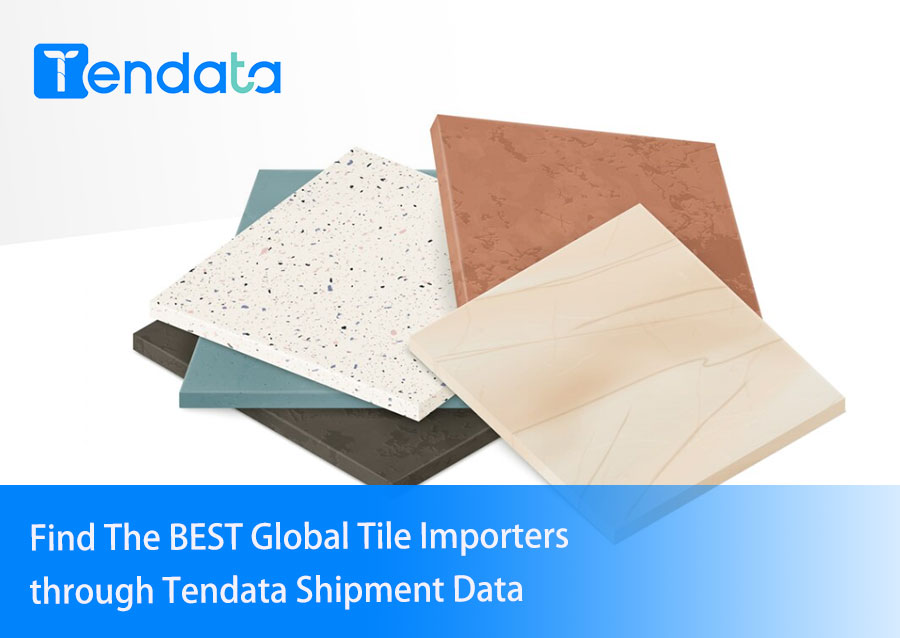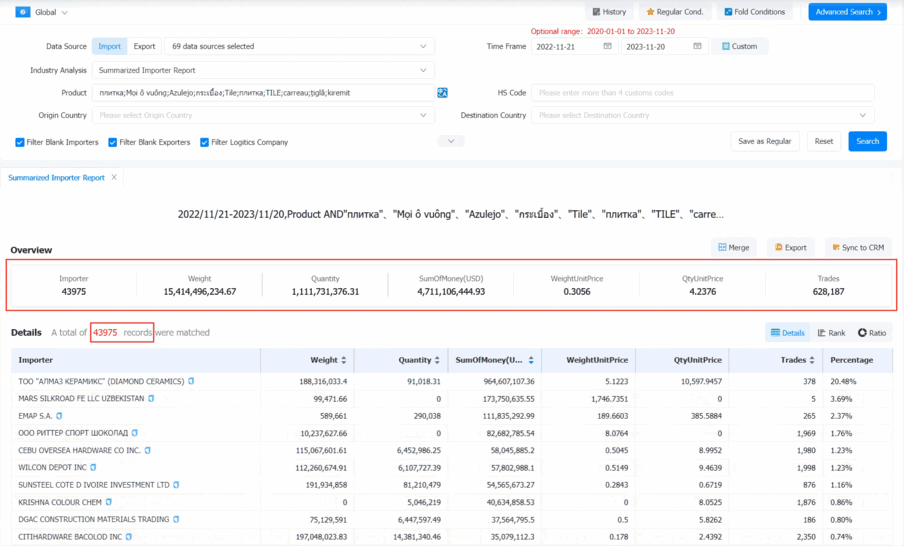 Import News
Import News
 2023-11-20
2023-11-20
Introduction
Tiles, ranging from ceramic and porcelain to natural stone and mosaic, are fundamental components in construction and interior design projects worldwide.
In the dynamic world of international trade, the importation of tiles plays a crucial role in meeting the diverse demands of construction and design industries. The global demand for quality tiles has spurred a robust import and export industry, connecting manufacturers with markets across continents. Global tile importers serve as crucial intermediaries, facilitating the seamless flow of diverse tiles across borders.

What types of tiles are often imported?
Various types of tiles are often imported, depending on factors such as design trends, availability of raw materials, and manufacturing expertise. Some commonly imported tiles include:
1. Ceramic Tiles: These are one of the most commonly imported types of tiles. They come in various finishes, such as glazed or unglazed, and are used for both floor and wall applications.
2. Porcelain Tiles: Known for their durability and resistance to moisture, porcelain tiles are often imported for use in high-traffic areas and outdoor spaces.
3. Natural Stone Tiles: Materials like marble, granite, travertine, and slate are popular choices for high-end projects. These natural stones are often imported due to their unique colors, patterns, and textures.
4. Glass Tiles: Imported for their aesthetic appeal and ability to reflect light, glass tiles are commonly used in backsplashes, bathrooms, and decorative applications.
5. Terracotta Tiles: These clay-based tiles are known for their warm, earthy tones and are often imported for their rustic charm.
6. Mosaic Tiles: Mosaic tiles, made from various materials such as glass, ceramic, or natural stone, are imported for intricate and decorative designs.
7. Wood-look Tiles: Ceramic or porcelain tiles that mimic the appearance of wood are popular for their durability and ease of maintenance. They are often imported to offer a wide range of wood aesthetics.
8. Hexagonal Tiles: Hexagon-shaped tiles have gained popularity for their geometric patterns, and they are often imported to provide unique design options.
9. Large Format Tiles: Tiles with larger dimensions are trendy for creating a seamless and modern look. Importing such tiles may offer a broader range of size options.
10. Patterned Tiles: Encaustic and patterned tiles, with intricate designs and colorful patterns, are frequently imported to cater to specific design preferences.
The choice of imported tiles can vary based on regional preferences, market demands, and the specific needs of construction or design projects. It's essential to consider factors such as quality standards, sustainability, and transportation costs when importing tiles.
Empowering Decisions through Tendata Shipment Data

To navigate this intricate landscape, leveraging data-driven insights becomes essential. Tendata Shipment Data emerges as a powerful tool for businesses involved in tile importation. By providing real-time insights into global trade patterns, it empowers stakeholders to make informed decisions, identify emerging opportunities, and streamline their supply chain.
1. Quality Metrics and Tile Varieties for Evaluating Tile Importers
Tendata Shipment Data allows businesses to assess tile importers based on critical quality metrics. From the types of tiles offered to the manufacturing standards and shipping conditions, understanding these metrics ensures that importers meet the stringent requirements for a successful trade partnership.
2. Identifying Trends in Tile Importation
Through Tendata Shipment Data, businesses can identify trends in the tile import market. This includes the rise of specific tile varieties, evolving design preferences, and the emergence of new players in the importation business. Staying abreast of these trends is key to adapting to market demands.
3. Adapting to Evolving Tile Import Dynamics
The tile import business is subject to evolving dynamics influenced by global events, economic shifts, and design trends. Tendata Shipment Data provides market analytics, allowing businesses to future-proof their strategies by adapting to changing market dynamics and staying ahead of industry shifts.
Conclusion
In the competitive realm of tile importation, finding the best global tile importers through Tendata Shipment Data is a strategic imperative. By harnessing the power of data-driven insights, businesses can navigate the complexities of international trade with precision, ensuring the quality, compliance, and success of their tile import ventures. As the industry evolves, embracing data analytics becomes the cornerstone for unlocking new opportunities and establishing enduring partnerships in the global tile market.
People who know current affairs know that customs data plays a very important role in the import and export industry, such as determining the target market, looking for overseas quality customers, avoiding transaction risks and so on are inseparable from customs data.

The following is a detailed description of these cases:
1. Determine The Target Market
When a company wants to sell its products abroad, accurate target market determination is key. The consequences of spending time and energy on developing a country where there is no need or very little demand for one's products can be serious. At this time, you can query the product through Tendata I-Discovery, analyze the import and export situation of the product in different regions of the world, and visually view the growth trend of import and export, so that you can know which countries in the world need the product the most, and then the target market can be basically determined. (>>Click to Get FREE DEMO)
2. Looking For Global Quality Buyers/Suppliers
Here to introduce you to a use of customs data to find foreign customers skills. Take the United States as an example: now use Tendata I-Discovery, in the query goods description at the same time, in the conditions of origin, enter CHINA, you can be exported to the United States of all the transaction records of the goods extracted. And then based on Tendata I-Discovery analysis report, the procurement volume of large U.S. companies extracted, which is a potential high-quality U.S. buyers.(>>Click to Get FREE DEMO)
3. Formulate Production Plan to Avoid Trade Risks
For a production enterprise, the development of its own production plan is related to the future trend of the enterprise for a period of time, Tendata I-Discovery allows you to see the real transaction records of each enterprise, as well as detailed information about the enterprise, to avoid the risk of being cheated in trade.(>>Click to Get FREE DEMO)
Category
Leave Message for Demo Request or Questions


 T-info
T-info T-discovery
T-discovery

 My
Tendata
My
Tendata Market Analysis
Market Analysis Customer
Development
Customer
Development Competitor
Monitoring
Competitor
Monitoring Customer Relationship
Customer Relationship





































































































































